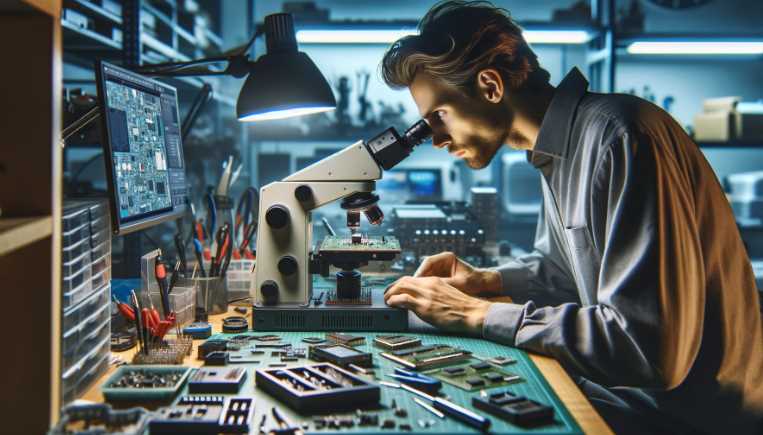Your image in a microscope may appear blurry if the focus is off, the lens is dirty, the sample is not prepared correctly, or the magnification is too high for the specimen.
| Image | Product | Detail | Price |
|---|---|---|---|
 | Carson MicroBrite Plus 60x-120x LED Lighted Pocket Microscope |
| See on Amazon |
 | Elikliv LCD Digital Coin Microscope |
| See on Amazon |
 | AmScope M150 Series Portable Compound Microscope |
| See on Amazon |
 | PalliPartners Compound Microscope for Adults & Kids |
| See on Amazon |
 | Skybasic 50X-1000X Magnification WiFi Portable Handheld Microscopes |
| See on Amazon |
| Factor | Impact on Image Clarity | Common Solutions |
|---|---|---|
| Out of Focus | Major | Adjust fine and coarse focus knobs |
| Dirty Lenses | Moderate to Major | Use lens wipes or air blower |
| Sample Preparation | Moderate | Thin and evenly spread sample |
| Magnification Level | Major | Use appropriate magnification for the sample size and clarity |
| Lighting | Moderate to Major | Adjust light source and condenser |

What Causes Blurry Images in a Microscope?
Blurry images in a microscope can result from several factors, ranging from improper setup to technical limitations. Below are the most common causes:
Poor Focusing Technique
The most frequent reason for blurry images is incorrect focusing. When the microscope isn’t adjusted properly, the specimen cannot be brought into sharp focus.
- Coarse Focus Misalignment: The coarse focus knob is intended for major adjustments to bring the specimen into approximate focus. Overusing it once close focus is achieved can distort the image, making it unclear.
- Fine Focus Misuse: The fine focus knob refines the sharpness of the image. Skipping or underutilizing this critical adjustment step can leave the image subpar and less detailed.
Dirty Lenses
Accumulation of dust, smudges, or oil on the lenses is another common culprit. These contaminants obstruct light and scatter it, resulting in a blurry or unclear view. Regular cleaning with proper materials is crucial to preserve lens clarity.
Improper Lighting
Uneven or insufficient lighting is a significant factor in unclear microscopy images. Proper illumination ensures that the specimen is lit evenly, allowing for a clear and detailed view. Issues with lighting may include:
- Misaligned Light Sources: A misaligned light source fails to properly illuminate the specimen, leading to uneven brightness and unclear regions.
- Low-Intensity Illumination: Insufficient light intensity can reduce visibility and the sharpness of details in the image.
- Incorrect Condenser Settings: A poorly adjusted condenser may fail to focus light onto the specimen effectively, resulting in reduced clarity and contrast.
Specimen Issues
The quality and preparation of the specimen significantly affect the clarity of the microscope image. If the slide is not prepared correctly, achieving a sharp focus can be difficult. Common issues include:
- Uneven Thickness in the Sample: Variations in sample thickness prevent the entire specimen from being in focus at the same time.
- Air Bubbles Trapped in Mounting Medium: Air bubbles distort light as it passes through, leading to blurry regions in the image.
- Overly Thick Coverslip: A thick coverslip can cause refraction issues, making it harder to focus clearly on the specimen.
Proper preparation of the slide, including careful placement of the coverslip and ensuring uniform sample thickness, is essential for clear imaging.
Magnification Limits
Using a microscope beyond its magnification capacity can lead to “empty magnification,” where the image appears larger but no additional detail is visible. This occurs because:
- The resolving power of the objective lens is exceeded, causing details to become blurred instead of sharper.
- Optical imperfections in the lens may be amplified, reducing image quality further.
To avoid this, always use a magnification level appropriate for the lens being utilized. Match the magnification to the resolving power of your microscope for the best results.
Misaligned Optical Path
Blurry or distorted images can result from misalignment in the microscope’s optical system, which disrupts the path of light. This misalignment prevents light from focusing correctly on the specimen. Common causes include:
- Loose Components: Parts such as lenses, eyepieces, or condensers that are not securely fixed can shift, causing misalignment.
- Misaligned Mirrors or Prisms: Mirrors and prisms that direct light within the microscope can become misaligned, leading to uneven or distorted illumination.
Regular checks and adjustments of optical components can help restore alignment and ensure a clear image.
Mechanical Issues
Over time, wear and tear in the microscope’s mechanical components can lead to blurry images. Precision is critical for maintaining focus and stability. Common issues include:
- Loose Stage Clamps: If the stage clamps do not hold the slide securely, the specimen may shift during viewing, causing blurriness.
- Unstable Focus Knobs: Worn or unstable focus knobs can make it challenging to achieve and maintain proper focus.
Addressing these issues may require tightening screws, replacing worn parts, or seeking professional servicing to ensure your microscope operates smoothly.
How to Fix a Blurry Microscope Image

Now that the causes are clear, here are effective solutions to address each issue and restore clarity to your microscope images.
Adjust the Focus Properly
Proper focusing techniques are essential for clear images:
- Begin with the coarse focus knob to bring the specimen roughly into view.
- Fine-tune the image using the fine focus knob for sharp clarity.
- Always adjust focus by moving the stage away from the objective lens to prevent damage to the slide and lens.
Clean the Lenses
Dirty lenses are a common reason for blurry images. Keep them clean with the following steps:
- Use a lens cleaning solution and a microfiber cloth to gently clean the eyepiece, objective lenses, and condenser.
- Avoid touching the lenses with your fingers, as skin oils can cause smudges.
- Perform regular cleaning to maintain optimal clarity.
Optimize Lighting
Proper lighting ensures even illumination and sharp focus:
- Verify that the light source is functioning and aligned correctly.
- Adjust the condenser to focus light directly onto the specimen.
- Use the diaphragm to control light intensity and improve contrast for better detail.
Prepare the Slide Correctly
Slide preparation significantly impacts image clarity:
- Ensure the specimen is thin and evenly spread across the slide.
- Avoid trapping air bubbles when placing the coverslip.
- Use the appropriate coverslip thickness, typically 0.17 mm, for optimal performance.
Match the Magnification
Using the correct magnification helps avoid “empty magnification,” which reduces clarity:
- Select the appropriate objective lens for the level of detail required.
- Avoid over-magnifying, as higher magnification does not always mean better clarity. Stay within the limits of your microscope’s resolving power.
Realign the Optical Path
Misaligned optical components can distort the image. To fix this:
- Inspect the lenses, mirrors, and prisms for misalignment.
- Tighten any loose parts carefully to restore proper alignment.
- Follow the microscope’s manual for alignment procedures to ensure precision.
Address Mechanical Problems
Regular maintenance of the mechanical components is crucial for consistent clarity:
- Inspect parts like the stage clamps and focus knobs for wear or instability.
- Tighten loose screws, knobs, or clamps to stabilize the microscope.
- If issues persist, seek professional servicing to resolve mechanical defects.
By following these steps, you can effectively fix blurry images and ensure your microscope performs at its best.
4 Tips for Preventing Blurry Images

Preventing blurry images starts with consistent care and correct usage. Follow these tips to keep your microscope functioning at its best:
Regular Maintenance
- Clean the lenses using appropriate solutions and microfiber cloths to prevent dust or smudges.
- Periodically inspect and tighten mechanical parts such as focus knobs and stage clamps to ensure stability.
Proper Storage
- Store the microscope in a dust-free and dry environment when not in use to avoid damage from moisture or contaminants.
- Use a protective cover to prevent debris accumulation on lenses and mechanical components.
Calibration
- Regularly calibrate the microscope to ensure proper alignment of optical components, such as the condenser and light source.
- Follow the manufacturer’s guidelines for calibration to maintain accurate functionality.
Training
Familiarize yourself with the microscope’s parts and settings, including lighting adjustments and magnification limits, to optimize performance.
Learn and practice proper focusing techniques to avoid over- or under-adjusting focus knobs.
Common Scenarios for Blurry Images

Understanding when blurriness occurs can help identify the root cause. The table below summarizes some common scenarios and their likely causes.
| Scenario | Likely Cause | Solution |
|---|---|---|
| The image starts clear but gradually becomes blurry | Slide shifts on the stage | Secure the slide with stage clamps |
| Blurriness at high magnification | Poor focus or empty magnification | Use the fine focus knob; reduce magnification |
| Uneven brightness across the field | Misaligned light source or condenser | Adjust the light source and align the condenser |
| Cannot focus on the entire specimen | Specimen too thick or improperly mounted | Prepare a thinner sample and remount the slide |
| Blurry spots in the field | Dust or smudges on lenses | Clean the lenses with a microfiber cloth |
Could Dirty Lenses Cause a Blurry Image?
Yes, dirt, dust, or smudges on the lenses can cause blurriness. Use lens paper and a cleaning solution specifically designed for optical lenses to clean the eyepiece and objective lenses. Avoid using tissue or cloth, as these can scratch the lenses. Regular cleaning prevents debris from obstructing the view and maintains the microscope’s performance.
What Role Does Magnification Play in Blurry Images?
Using the wrong magnification can make an image appear blurry. If you magnify beyond the resolving power of the objective lens, the image will lose clarity. Start with a lower magnification to locate the sample, then gradually increase it while adjusting the focus to maintain sharpness. Remember that higher magnification requires precise focus and optimal lighting.
How Can Poor Lighting Affect Image Quality?
Inadequate or uneven lighting can make it challenging to see the specimen clearly. Ensure the microscope’s light source is functioning properly and adjust the diaphragm or condenser to control the amount of light. Too much light can cause glare, while too little light results in dim and blurry images. Balance the light for the best viewing experience.
Does Improper Sample Preparation Cause Blurriness?
Yes, a poorly prepared sample can lead to blurry images. Ensure the specimen is properly mounted, thinly sliced if necessary, and coverslipped to keep it flat. Air bubbles, uneven placement, or contamination on the slide can distort the view. Taking time to prepare the slide correctly improves image clarity significantly.
Why Is My Microscope Still Blurry After Focusing?
If the image remains blurry despite focusing, check for issues such as misaligned lenses, a loose stage, or a damaged focus knob. Test the microscope with a prepared slide known to produce clear images. If the problem persists, the microscope may need professional maintenance or repair.
How Does Lens Alignment Affect Image Sharpness?
Misaligned lenses can cause blurriness by disrupting the optical path. Ensure the objective lenses click securely into place when rotating the turret. Alignment issues are often resolved by checking the microscope’s mechanical adjustments and ensuring all parts are secure.
Can a Wobbly Microscope Stage Create Blurriness?
A wobbly or unstable stage can lead to difficulty focusing and blurry images. Tighten the stage and ensure it moves smoothly. When placing the slide, make sure it is secured with stage clips or a slide holder to prevent movement during observation.
Is My Microscope’s Resolution Limiting the Image Quality?
Yes, each microscope has a resolution limit based on its optical components. If your microscope’s resolution is insufficient for the level of detail you need, the image may appear blurry, especially at higher magnifications. Upgrading to a higher-resolution microscope may be necessary for advanced observations.
How Can I Avoid Blurry Microscope Images in the Future?
To avoid blurry images, regularly clean the lenses, prepare slides carefully, ensure proper lighting, and verify that all microscope components are in good working order. Familiarize yourself with the focus and magnification adjustments to optimize the viewing experience. Periodic maintenance of the microscope also ensures long-term clarity.
Final Thoughts
Achieving a sharp image with your microscope requires attention to detail and regular maintenance. By addressing the common causes of blurry images and adopting proper techniques, you can enhance your microscopy experience. Remember, clear imaging depends on the harmonious interplay of focus, lighting, and specimen preparation. A well-maintained and correctly used microscope will deliver precise and reliable results for your studies or work.

I am an enthusiastic student of optics, so I may be biased when I say that optics is one of the most critical fields. It doesn’t matter what type of optics you are talking about – optics for astronomy, medicine, engineering, or pleasure – all types are essential.
Table of Contents
